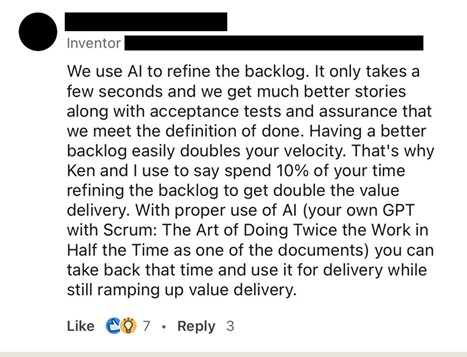Peter Tucker, 25 April 2025
In his book Deep Work: Rules for Focused Success in a Distracted World, Cal Newport (2016) suggests that people who have the ability to focus on a difficult problem for an extended time, are also able to focus deeply and carefully, and have a competitive advantage. He says few people are able to focus and think deeply. In fact, due to the increasing number of distractions that we surround ourselves with, the percentage of people with this skill will decrease. Further, our culture values efficiency. We value getting many things accomplished quickly. And for this reason, we celebrate ways that AI can help us get tasks done even faster.
I ran across a LinkedIn post that illustrates these values:

In software development, Scrum is a set of practices for developing technology that many organizations have adopted, and employs backlogs, user stories, and acceptance tests. A backlog is a list of tasks that need to be accomplished to realize the software solution a team is working towards. Backlog refinement is a team meeting that can take 2+ hours. In that meeting, the team looks over each task in the backlog and works through the details of the task, with the goal that anyone on the team can pick that task up and complete it. User stories illustrate how a user will engage with the results of that task, helping the team understand the purpose of that work. Acceptance tests are generated to help the person working on the task know whether they have completed the task – once all acceptance tests pass, they can move on.
This LinkedIn post celebrates efficiency using AI. Instead of a two-hour meeting of 8-10 people, they feed the backlog into AI and get “much better” results in a matter of seconds. The team can get straight to work on delivery, and the software solution will be available to users and clients so much sooner. If we think about money saved and estimate that each team member makes $150/hour (a gross estimate), we’ve saved the company $1200! If a team does backlog refinement every two or three weeks, then AI has saved the company between $20,000 and $30,000 per year. That does seem worthy of a celebration.
In a blog post on scrum.org, a user asked about using ChatGPT to boost efficiency during Scrum activities including the backlog refinement meeting (https://www.scrum.org/forum/scrum-forum/80440/chat-gpt). The response to that question lists most Scrum activities, and ways to use AI to complete those tasks faster.
Are there drawbacks? Are there reasons to value spending time on things that can be completed much faster and cheaper simply by employing AI? I guess if I didn’t think there were, I wouldn’t be writing this. My colleague Scott Griffith talks about the value of joy in the time and effort required to create something. He describes the love he has for the process and the joy he gets from working through the process even when a tool such as AI could do it faster and cheaper. I think that joy is an important part of this discussion. My focus here is on how taking the inefficient approach can produce better outcomes long-term. In my view, the tension is a tradeoff between near-term gains vs. long-term gains.
Let’s take the case of product backlog refinement meeting. Again, each item in the backlog is a task that, once completed, will get our team closer to completing the software solution. There are a number of tangible outcomes from this meeting:
- A clearer description for each task.
- User stories that show how the results of each task will help the user complete their goals.
- A list of acceptance tests for each task to let the developer(s) and the team know when the task is complete.
Clearly AI can be employed to accomplish these tasks and might well come up with descriptions that may be clearer than what the team would write, more user stories to illustrate how each task will be used, and a more robust list of acceptance tests. If we focus only on tangible outcomes, we could argue that AI will likely do backlog refinement better than the team would have, and much more quickly.
In Deep Work, Newport defines deep work as “Professional activities performed in a state of distraction-free concentration that push your cognitive capabilities to their limit. These efforts create new value, improve your skill, and are hard to replicate.” Further, he defines shallow work as “Non-cognitively demanding, logistical-style tasks, often performed while distracted. These efforts tend to not create much new value in the world and are easy to replicate.” He argues that “Our work culture’s shift towards the shallow is exposing a massive economic and personal opportunity for the few who recognize the potential of resisting this trend and prioritizing depth.”
Newport says that deep work is a skill that has great value for two reasons: First, that deep work is required to learn complex things quickly. Our world is changing quickly, and AI is accelerating those changes. Keeping up with those changes requires continuous learning. Thinking back to the example of backlog refinement, employing AI deprives us from learning and deeply understanding the client’s needs for what we are building. As a development team, we avoid the hard, focused work of clarifying each task, developing user stories for that task, and considering appropriate acceptance tests. We end up with a very shallow understanding of each task, despite the great work AI did for us. We avoided the two-hour meeting, but when we take on development work, we don’t have the depth of understanding needed to really complete the task well.
Newport’s second reason for the great value of deep work is that, in order be successful, you have to produce “the best stuff”, and producing great stuff requires deep work. Anyone can produce mediocre work. Products created by AI have to be considered mediocre since anyone can create nearly the same thing. We all have access to ChatGPT, Claude, Grok, and whatever comes next. In our running example, AI may have refined the tasks in a backlog, but since the team didn’t take focused time to deeply understand each task, it will be challenging to produce anything but mediocre results.
Let’s consider examples outside of technology development. In education, students take courses with the goal of earning a good grade. They could approach each assignment and exam with the understanding of what they need to do to make that grade (i.e. follow the rubric), and simply do what is necessary. They could even prompt AI with the assignment and rubric to achieve the goal. Alternatively, a student could take the course with the goal of learning material deeply. That is, use deep work techniques to invest in learning the material. That deep work approach obviously requires more time and discipline. At the end of the term, both students would likely earn the same grade. Near-term, you could argue the rubric-focused student was more efficient. However, in subsequent courses, the student who put in the time and effort to learn the material with depth will perform better. That student will be more prepared for later courses and for life after graduation than the rubric-focused student.
Here’s another example: If I plan to visit another country, it is clearly important to learn the language. I’m going to want to be able to communicate with the people I encounter. There are a number of tools, most of them free, that can teach me a language. In truth, I don’t even need to learn the language – I can simply show up with phone in hand. I can let my phone listen to another person speaking and translate it for me in my native language. I can then respond and have my phone translate my response audibly to that person’s language. Brilliant! So efficient! Another approach would be to spend time focusing on the language as well as the culture of the region I plan to visit, to understand carefully how people in that region approach life and what they value. In both approaches I can have a good experience and communicate with others. But if I take the deep work route, I’ll be able to better immerse myself into my surroundings and get the most from my visit. In truth, the people I encounter on my visit will have a better experience with me if I take the time and effort to understand their language and culture.
I think the tension of near-term gains vs. long-term gains is more a question of when are we willing to accept mediocre results, and when do we want great results. Great results will always take deep, focused time and effort. AI might be able to support some of that effort, but we’ll always need to remember that if our client is using something created by AI, then they’re using something mediocre, that anyone can create.
